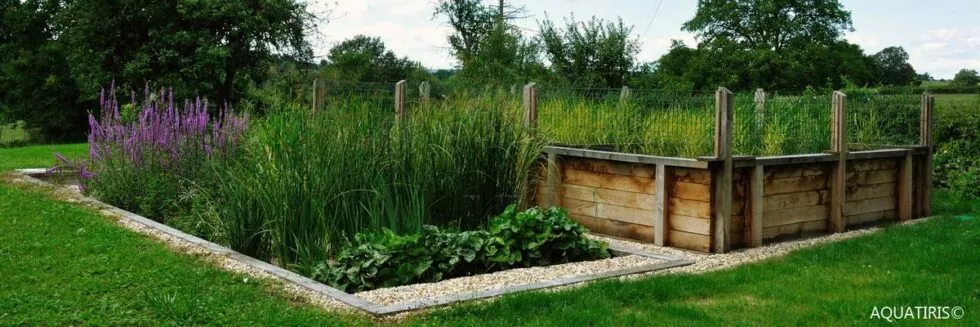Phyto-purification is all well and good, but is it authorised for my house?
The answer is yes! But beware, certain conditions apply!

Phyto-purification is a wastewater treatment technique that is gaining popularity thanks to its ecological approach. But is it authorised for your home? The good news is that it is! That’s why it’s essential to take certain conditions into account to ensure that this system is set up in accordance with local regulations.
Definition and issues of individual sanitation
Individual ecological sanitation, or non-collective sanitation (NCS), refers to all individual domestic wastewater treatment facilities. It encompasses all the devices and techniques used for the collection, treatment and disposal of domestic wastewater from homes not connected to the sewer system. These fluids include black water (from the toilet) and household water (from daily activities such as cooking, bathing, etc.).
The main individual sanitation systems
There are various individual sanitation solutions that you can install in your home.
Phyto-purification system
A natural and sustainable sanitation method using plants, phyto-purification allows for depollution thanks to the purifying properties of the roots of specific plants. This is done by integrating a natural marsh. The mechanism of phyto-purification is based on the use of plants such as reeds which act as a ‘vertical filter’ to purify wastewater.
Once the water enters the system, it is drawn in, filtered and digested by the plants, particularly at the level of the root complex which is rich in micro-organisms. The ecosystem thus created mainly treats the nitrates, phosphates and metals retained by the water. This eliminates the pollutants present in the water.
The principle of phyto-purification is similar to that of composting. The degradation of pollutants in contact with air produces humus and water vapour. The process is complete once the plants and rushes have had time to colonise each box.
The ecological advantages of a phyto-purification system
Phyto-purification has ecological advantages. This system is an ecological sanitation solution that does not require tanks or the use of large amounts of materials. Macrophyte plants adapt to all types of soil and are resistant to temperature variations and frost. Moreover, although it takes place in the open air, this system does not produce any unpleasant odours. It is also easy to maintain: simply weeding the basins in the spring is enough.
A phyto-purification installation also does not require fossil fuels to operate and the resulting water can be discharged directly into the natural environment without risk.
All-water septic tanks
Unlike the traditional septic tank, which only treats black water, the all-water septic tank collects and pre-treats all domestic wastewater. Only rainwater does not pass through this ecological septic tank system as it does not need to be decontaminated before use. Currently, this type of tank is the only one authorised by regulations, given that the installation of septic tanks is now prohibited.
An all-water septic tank is generally a plastic or concrete tank, equipped with an inlet and outlet circuit.
- sand filter,
- planted filter (reed filter),
The device is designed to be watertight, thus preventing the infiltration of wastewater into the soil. The tank must be resistant to pressure and corrosion in accordance with the mandatory CE standard. It is also equipped with ventilation to evacuate potentially harmful fermentation gases. Pre-filters can be added upstream or downstream, and inspection holes are provided for easy access for maintenance, emptying and inspection purposes.
In addition to collecting and retaining domestic wastewater and its pollutants, this individual sanitation system performs several other functions. It liquefies solid matter (accumulation of sludge and grease) to enable it to be treated later in an appropriate way. It also retains solid matter (decanting sludge) and floating matter (grease).
However, this system does have disadvantages. There is a possibility of overflow. Foul odours can also rise to the surface. Plants can also infiltrate the system and block it, which can be difficult to repair.
Micro-treatment plants
The micro-treatment plant is a watertight wastewater treatment device in which the entire treatment process takes place:
- pre-treatment,
- treatment,
- discharge.
It manages the storage, anaerobic degradation (thanks to bacteria) and decantation of suspended matter. It also ensures the retention of sludge, the hydrolysis of grease and the production of ammonium, all in three separate compartments.
There are two main categories of micro-treatment plants: fixed cultivation (where the bacteria are fixed to supports) and free cultivation (where the bacteria are in suspension). In both cases, the filters are pre-treated with specific enzymes to reinforce the development and capacity of the bacteria to effectively decontaminate the water.
Despite their many qualities, micro-treatment plants have one major limitation: they must operate with a permanent power supply. With this individual sanitation system, the treatment cycle must be activated continuously to prevent the bacteria from dying. The micro-treatment plant is therefore not suitable for a second home. It also requires frequent emptying due to the rapid accumulation of sludge as a result of its compactness.
Opt for Sanitation Gardens
The network of experts and installers of Aquatiris individual sanitation systems is available to meet your needs. They respond quickly by providing personalised and sustainable solutions throughout the project. You can choose a single-level Sanitation Garden with a reed filtering bed. Double-level phyto-purification systems are also available, such as the filters of the Iris and Carex ranges. All these solutions have been awarded the CE marking by the Ministries of Health and the Environment.
Unlike traditional systems, it is not necessary to empty the tank. The planted filtering beds do not emit any odours and blend in harmoniously with the landscaping of your home.

